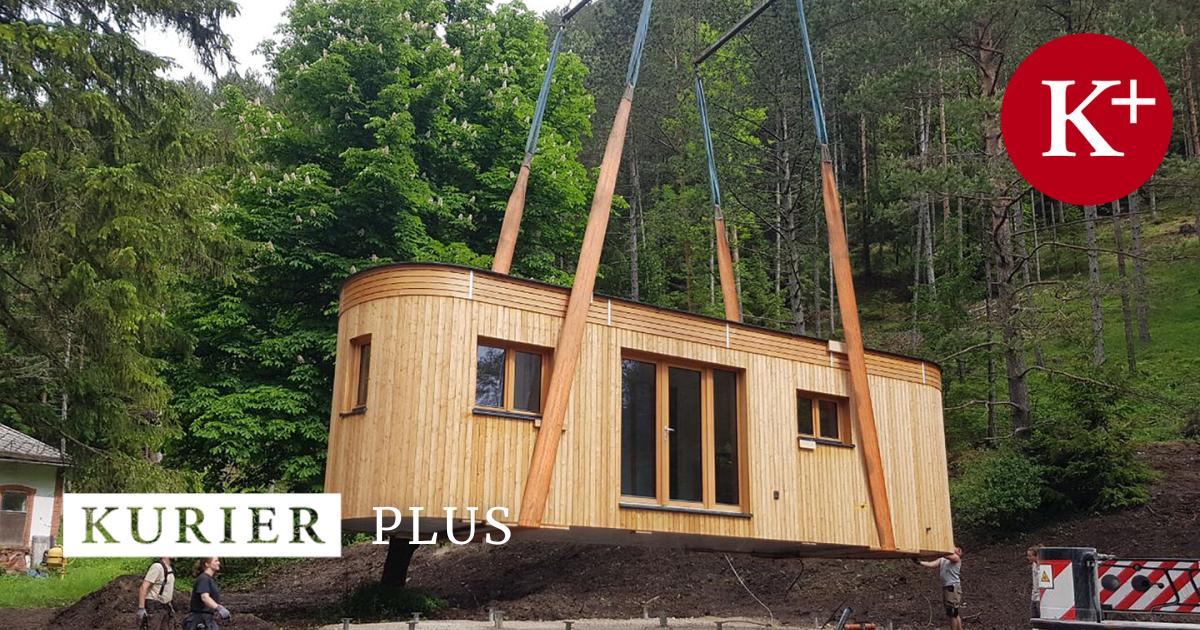The houses are getting bigger
Then it was time for the next step: Wohnwagon expanded its offering to include individual modular homes for families. Solid wood houses with up to 500 square meters of living space are built. “The development towards larger projects arose from customer demands, because many have living needs that cannot be covered in 30 square meters,” says Theresa Mai. Many families have contacted us who wanted a caravan.
The big question then was: “How can we implement a big concept with the values we stand for,” said the managing director. The family houses that are now being planned are 20 to 40 percent smaller than the average Austrian single-family home. In addition, usage concepts were developed across generations so that the house can be adapted to the respective use. “We build in such a way that we integrate the conversion into the floor plan,” explains Mai. This could be an office or a separate apartment to provide space for a carer.
Production in Lower Austria
Production has been adapted to the family houses; the modular buildings are manufactured in our own workshop in Gutenstein. Instead of one module, the two-story houses now consist of several modules that can be transported and are erected using a crane. “Many people use existing properties with neighbors and friends,” says Mai, referring to the Wohnwagon property exchange, which lists over 60 properties that can be bought or leased.
Without floor sealing
Even the larger projects do not require soil sealing because they are based on screw foundations. The big advantage: There is no need to pour concrete and the buildings can still be dismantled. “Everything is finished in the workshop: the kitchen and bathroom are installed, the tiles are laid,” says Mai.
The construction site on site only takes a few days – then the finished house can be moved into. While the smaller caravans with up to 60 m2 While they cost 150,000 to 250,000 euros, the price for family houses is 250,000 to 400,000 euros, depending on size. They are largely self-sufficient, “but there is a backup via the network,” says Mai.
Reuse instead of throwing away
The Viennese company also comes without soil sealing Lukas Lang Building Technologies when building his pavilions from solid wood elements. The buildings are screwed into the ground, require little construction time, can be dismantled without leaving any residue and their elements can be reused for other houses. “Not only is this environmentally friendly, it also reduces construction costs and offers exceptional flexibility,” explains Managing Director Christian Leitner. However, they are not only suitable for temporary use, but also as a permanent solution.
There is no building rubble
The motto is to reuse instead of throw away. The most recent example is the kindergarten in Spillern (Lower Austria), which needed more space. In the first step, a fully-fledged transitional quarter with Lukas Lang’s elements was built on the green meadow. Meanwhile, in the second step, the new building was erected on a floor slab, where not only new but also the temporarily used building elements of the kindergarten were used. Thanks to this construction method, the new building has a lot of potential for expansion.
“After dismantling the temporary kindergarten, we were left with a green meadow and only had to dispose of screws and some insulation material. We don’t have any building rubble,” says Leitner.
New on the market
The newest provider of prefabricated houses in Austria also relies on a lot of wood and flexible modules: Schwabenhaus opened its model home on October 5th Blue Lagoon in Vösendorf (Lower Austria). The German manufacturer produces the components in Hesse. However, managing director Christian Baumann promises that 75 percent of the added value should remain in Austria, as local companies will take over the construction work.
The goal is to sell 30 houses in 2025. The smallest model is available with 95 square meters of living space. According to Baumann, the delivery time is three months and the construction time is also three months. As a special service, the company would also like to provide support in the search for the right property thanks to cooperation with local real estate agents.

New Social Bookmarking | Best Bookmarking Sites List
Ace Directory .org
Best Social Bookmarking Sites 2022
Rehabs in Orange County – WriteUpCafe.com
404 Not Found
Rehabs in Orange County: website, address, contacts — Directory of companies Cataloxy.us
Best Social Bookmarking Sites 2021
Rehabs in Orange County – Terry Henry – Medium
Complaints & Reviews: Rehabs in Orange County | TrustLink
Rehabs in Orange County 3318 N Cottonwood St, Orange, CA, 92865, USA 92865
Rehabs in Orange County | A Listly List
Rehabs in Orange County, Orange 92865, Rehabilitation, Healthcare
Back Page Dir .com : Rehabs in Orange County
Best Social Bookmarking Sites 2022
Hot Directory .net
Account Suspended
Rehabs in San Bernardino – James Foster – Medium
Rehabs in San Bernardino 109 N Plymouth Way, California 92408
Rehabs in San Bernardino – WriteUpCafe.com
404 Not Found
Free Classifieds at USNetAds.com – View Item Content by ID 132275001
Rehabs in San Bernardino in San Bernardino, CA
Rehabs in San Bernardino – Health and Wellness – San Bernardino, CA 92408
Just a moment…
Rehabs in San Bernardino – Classified Ad
Best Social Bookmarking Sites 2021
MediaFire Direct Link .com
Family Dir .com : Rehabs in San Bernardino
PopularDirectory.biz
Rehabs in San Francisco : Addiction advice and treatment services